Pros
-
Liquid Display XDR is superb
-
Class-leading performance
-
Useful, high-quality accessories
Cons
-
11-inch model lacks display upgrade
-
Accessories greatly increase price
-
IPadOS is in an awkward phase
About the 2021 iPad Pro
- Chipset: Apple M1
- Display: 11-inch Retina LCD or 12.9-inch Liquid Retina XDR Mini-LED
- RAM: 8GB to 16GB
- Storage: 128GB, 256GB, 512GB, 1TB, 2TB
- Rear-facing camera: 12MP wide, 10MP ultrawide with LiDAR
- Front-facing camera: 12MP ultrawide with FaceID
- Wired connectivity: USB-C
- Wireless connectivity: Bluetooth 5, Wi-Fi 6, Cellular 5G/4G LTE
The 2021 iPad Pro is its largest generational upgrade ever, but you wouldn’t know that by looking at it. The iPad Pro 11-inch and 12.9-inch look nearly identical to their predecessors.
Inside, though, the iPad Pro is all-new. It now has the M1 chip Apple built for the MacBook Air, Pro, and 24-inch iMac. You can, for the first time, configure the iPad Pro with up to 16GB of RAM and up to 2TB of internal storage. And the 12.9-inch model packs a revolutionary Mini-LED display.
Despite this, pricing has barely budged, with only the 12.9-inch pushed up by $100. While many shoppers will consider these prices high, I wouldn’t say they’re overpriced, as you’ll pay just as much for a high-end Windows 2-in-1. Here’s the pricing rundown, including accessories:
- 11-inch iPad Pro: $799 for 128GB, $899 for 256GB, $1,099 for 512GB, $1,499 for 1TB, $1,899 for 2TB. Add $200 for cellular.
- 12.9-inch iPad Pro: $1,099 for 128GB, $1,199 for 256GB, $1,399 for 512GB, $1,799 for 1TB, $2,199 for 2TB. Add $200 for cellular.
- Magic Keyboard: $299 for the 11-inch, $349 for the 12.9-inch
- Apple Pencil (2nd-gen): $129
The 2021 iPad Pro’s upgrades are massive. Apple has marketed the iPad Pro as a laptop alternative for years, but its internals were derived from the iPhone. Now, it shares the same powerhouse chip as the laptop lineup. But the real revolution is the Mini-LED display which, unfortunately, is only included with the larger, more expensive model.
What we like
Liquid Display XDR display is a revelation
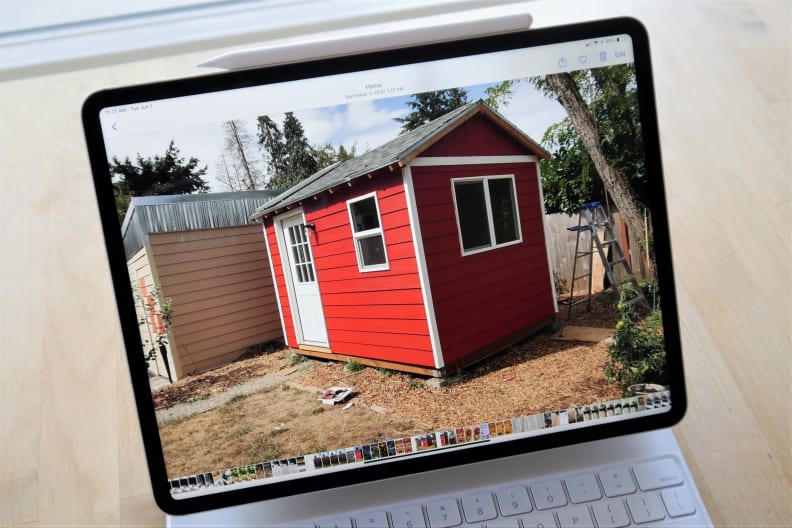
The 12.9-inch version of the 2021 Apple iPad Pro has a bright, vibrant display with Mini-LED technology.
The Liquid Display XDR screen in Apple’s 12.9-inch iPad Pro might be the most significant innovation in consumer electronics this year.
At its core, the Liquid Display XDR is Apple’s spin on Mini-LED display technology. This came to televisions years ago, but Apple has managed to miniaturize the tech while arguably improving its quality. A quality Mini-LED television usually offers a few hundred backlight zones that can turn on or off independently to improve contrast. The iPad Pro 12.9 has 2,596.
Because of this, the 12.9-inch iPad Pro can achieve deep, inky dark levels that approach those of an OLED display, yet also reach a much higher maximum brightness. With a claimed 1600 nits peak brightness, Apple’s Liquid Display XDR buries the HDR brightness of any OLED screen we've come across, and it shows.
Liquid Display XDR turns a flashy HDR movie like Avengers: Endgame into a handheld fireworks show. But it’s not just movies and games that look great. The display’s extreme contrast and high brightness make it ideal for editing photos and movies, browsing the web, or writing in Word.
It’s not perfect. You may notice small, hazy patches around bright objects when they’re on a dark background. This issue is minor, however, and rarely noticeable in real-world use.
The display also benefits from Apple’s long history of improvements in mobile display technology. It has a 120Hz refresh rate for responsive and smooth scrolling, uses True Tone to improve perceived quality in different lighting conditions, and supports a wide range of colors.
Liquid Display XDR has raised the bar on display quality. Apple’s rivals will be tripping over themselves in a rush to emulate it.
The accessories are unmatched
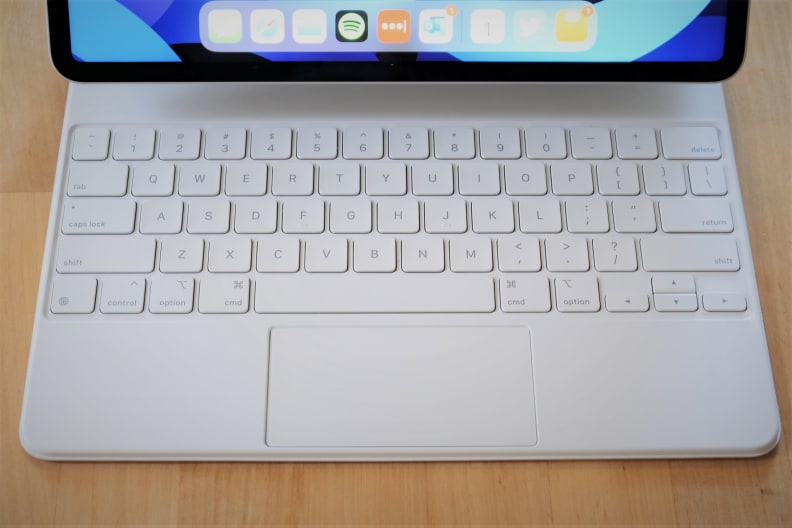
The Magic Keyboard is a fantastic accessory.
Apple’s Magic Keyboard and Pencil haven’t changed significantly since the last time around (though there is a new Magic Keyboard, as the first-gen Magic Keyboard doesn’t perfectly fit the new 2021 iPad Pro).
Still, the iPad Pro’s accessories remain at the top of the pack. The Magic Keyboard is a delightful input device that feels much like using a “real” laptop. Each keystroke is crisp, tactile, and responsive. The touchpad, though not large, is agile and smooth.
You will have a slightly different experience depending on the size of iPad Pro you buy. The smaller, 11-inch model feels more balanced and portable, but the heavy 12.9-inch version is more comfortable when typing.
Apple’s second-generation Pencil is the same for both sizes. The Pencil was always ready for use when I picked it up and felt smooth as I jotted down reminders in Microsoft OneNote. There’s no lag, stuttering, or false inputs to struggle through.
I have one complaint: the Pencil’s magnetic connection to the iPad Pro could be more secure. It occasionally fell off the tablet as I picked it up or placed it in a bag.
I’m not sure I’d call the Apple Pencil superior to Microsoft’s Surface Pen, which is my favorite stylus in the Windows world, but it’s at least on par. The Apple Pencil definitely outperforms other stylus options like Lenovo’s Pen Pro and Samsung’s S Pen. This has less to do with responsiveness than with design, as many rivals feel small or awkwardly shaped in my hand.
Apple’s M1 chip wins again
The iPad Pro was the fastest tablet in the world. Somehow, the new model drastically upgrades its performance.
The M1 chip, first introduced in 2020, was a massive win for Apple’s MacBook line. It managed to outperform rival Intel and AMD processors while using less power and without an increase in price. Reviewed’s Adrien Ramirez loved the new M1-powered Air, calling it the “best laptop you can buy.” It is still Reviewed’s top-rated laptop.
The M1 continues its string of victories in the iPad Pro. The M1 chip is up to 50% quicker than the prior iPad Pro’s A12Z, which was already the fastest processor available for any Android or iOS tablet.
Placing this chip in the iPad Pro often feels like overkill. Every app available on the tablet runs flawlessly. This includes not just photo editing but more subtle system killers, like a massive Google Docs spreadsheet or a Trello board with too many projects. The iPad Pro never blinks.
To say something is overkill, though, usually implies there’s a downside. Not here. The 2021 iPad Pro is absurdly fast yet still lasts eight to 10 hours on a charge and remains cool to the touch. Both the 12.9-inch and 11-inch models perform well, though the smaller version will throttle performance more aggressively in sustained, demanding workloads.
The 2021 iPad Pro also has more RAM than ever before. Models with 128GB, 256GB, and 512GB of storage have 8GB of RAM, while those with 1TB or 2TB of storage have 16GB of RAM.
I wasn’t able to find a specific app that obviously benefited from this upgrade, but it should keep the 2021 iPad Pro relevant for years to come, and will give developers room to expand the capabilities of future iPad apps.
The extras are aces
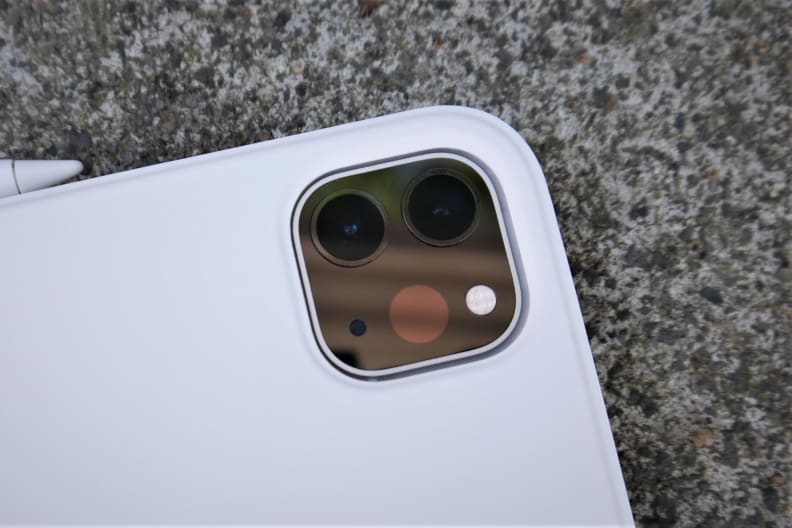
The Apple iPad Pro has a fantastic rear-facing camera.
Apple’s Liquid Display XDR and M1 chip are the 2021 iPad Pro’s headline upgrades, but don’t let them overshadow the rest of the tablet.
The iPad Pro is packed with excellent tech. The front-facing webcam is outstanding and supports FaceID login, while the rear has a superb camera array that includes an ultrawide lens and supports LiDAR for Augmented Reality apps. The speakers are loud, clear, and have a hint of bass, while the built-in microphone was able to pick out my voice from across my home office and (mostly) push out the background hum of a fan.
These extras make the iPad Pro more useful for work and play. You can use the tablet as a portable speaker, a small TV, or a mobile video conferencing system. It’s possible to use an iPad or iPad Air the same way, but the iPad Pro delivers a significant upgrade across the board.
What we don’t like
Liquid Display XDR is exclusive to the larger iPad
The revolutionary Liquid Display XDR is a must-have feature. Unfortunately, it’s only included with the larger 12.9-inch iPad Pro. This is a real pickle for shoppers who want the smaller model (which, historically, is most of them).
There’s no question the new display is a massive success. Apple will likely roll out this tech across all future Apple tablets and laptops. Perhaps the 11-inch iPad Pro will get it next year. If that happens, shoppers with the smaller 2021 iPad Pro will feel left out.
The 12.9-inch model is too heavy
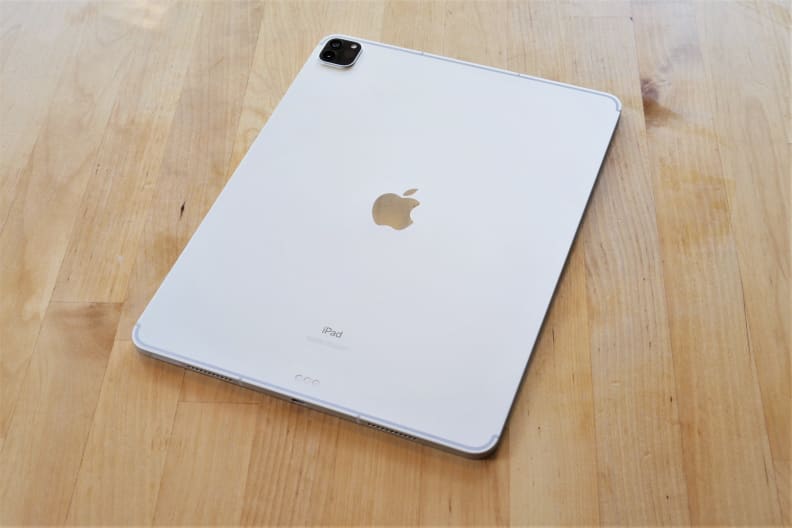
The 2021 iPad Pro looks almost identical to the prior generation.
To make matters worse, the 12.9-inch model (which I tested) is too large and heavy for anyone who wants to use the iPad Pro as a tablet most of the time.
The 12.9-inch iPad Pro weighs about 1.5 pounds. The Magic Keyboard increases that to about three pounds. The larger iPad Pro with keyboard isn’t unbearably heavy, but it’s far more difficult to pack and tote around than the 11-inch iPad Pro or the iPad Air. The sheer size of the display is an issue, too, as it makes the larger model uncomfortable to hold while watching video or browsing the web.
The accessories feel mandatory
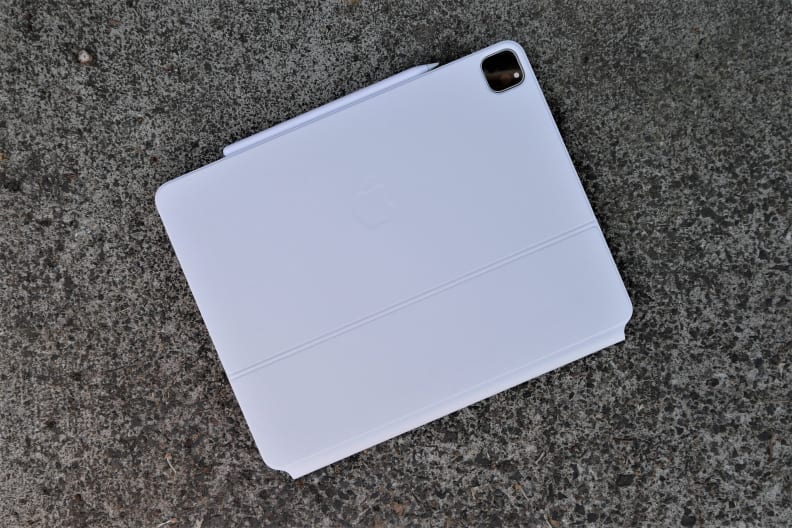
The Magic Keyboard now comes in white, which looks great but does collect dust.
Apple’s iPad Pro is sold as a tablet but, in reality, it’s more of a 2-in-1. This isn’t to say it’s unusable without accessories. The 11-inch iPad Pro is a great tablet. It does everything the iPad and iPad Air can do, but better.
But that’s the problem. The iPad Pro, if used without its accessories, seems like a device in search of a purpose. Yes, the iPad Pro is technically “better” for online shopping, or playing games, or watching YouTube, but the gap isn’t large enough to justify the premium.
You’ll only appreciate the iPad Pro’s strengths if you use it for illustration, photo editing, project management, or another demanding task that’s sure to prove difficult without at least the Apple Pencil and, ideally, the Magic Keyboard.
This increases the price. A base 11-inch iPad Pro starts at $799 for 128GB of storage, which seems fair enough: it’s $200 less than the MacBook Air. Throw in the Magic Keyboard and 2nd-generation Apple Pencil, however, and you’re suddenly spending $1,227. The 12.9-inch model starts at $1,577 with keyboard and stylus. That’s MacBook Pro money.
iPadOS is still awkward
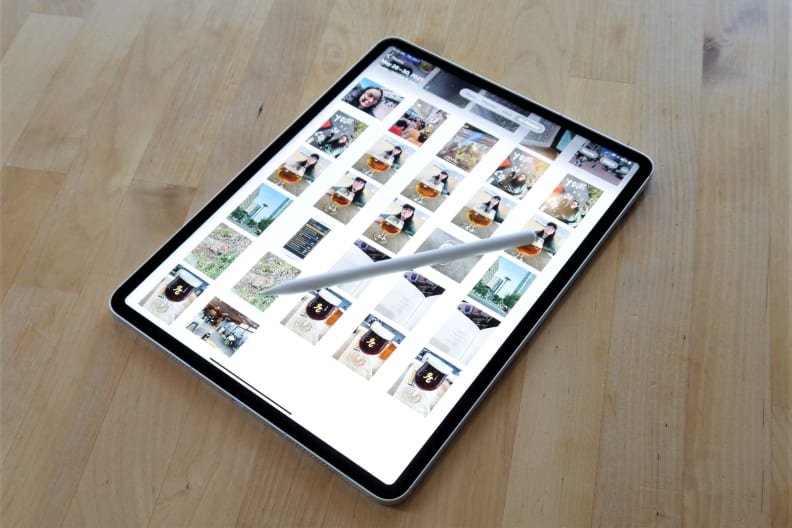
The 12.9-inch iPad Pro provides plenty of space for organizing photos.
The iPad Pro’s accessory issue goes hand-in-hand with the awkward state of iPadOS. It’s a smooth, attractive, and secure operating system with plenty of applications. It’s also a mish-mash of ideas that don’t always come together.
Take file management, for example. A file manager is included in iPadOS and works reasonably well, but transferring files between apps, or to cloud platforms, is a true chore. Different apps interface with the file manager in different ways, which can make file transfers confusing, especially when using an app for the first time.
Lackluster multitasking doesn’t help. File management is easy in MacOS and Windows because you can easily open a folder (or folders) and view contents side-by-side. This often isn’t possible in iPadOS, as you can only view two apps side-by-side, and some don’t even properly support that.
This is just one example of the larger problem: Apple seems unsure whether the iPad Pro should be a true Mac alternative. It now has support for any external keyboard (whether it be the Magical Keyboard or otherwise), which is wonderful, but it doesn’t work well in all apps, which is a problem. External display support is mostly limited to mirroring the iPad Pro’s screen, but a handful of apps can extend to a second display. Mouse support usually works fine but falls short in key areas, like drag-and-drop.
The degree to which these problems bother you will depend on how you plan to use the iPad Pro. It’s a superb 2-in-1 (the best, in my opinion) because it’s more powerful than a Microsoft Surface Pro or Lenovo ThinkPad Yoga. If you’re transitioning from a laptop, though, you may run into situations where your usual workflow must change. You can do just about anything on an iPad Pro, but it’s not always as easy Apple’s marketing suggests.
Warranty
Apple ships the iPad Pro with a one-year warranty against manufacturer defects. Owners can purchase the company’s AppleCare+ extended warranty alongside the tablet or within 60 days.
Should you buy it?
Yes. The 2021 iPad Pro is the best tablet ever (but you’ll pay for it).
The 2021 iPad Pro is an amazing piece of technology, and the 12.9-inch model is especially impressive. The Mini-LED display and ridiculously fast M1 processor create an unrivaled experience. This iPad truly earns its “Pro” title. Aside from a few edge cases, like multiple display support, it can handle anything you’d throw at the M1-powered MacBook Pro 13.
While the iPad Pro is great for pros who want a high-performance tablet, it’s also an excellent luxury computing device. I’ve used a 2016 iPad Pro for years and have few complaints about its day-to-day usability. Yet there’s no denying the 2021 iPad Pro is in a different league.
The iPad Pro is not the best value, which is why Reviewed generally recommends the iPad Air as the best tablet for most people. However, if you have $2,000 or more to blow on a computer, and you want something that feels like the future, buy the 12.9-inch iPad Pro with a Magic Keyboard and Pencil.
My only real complaint is that Apple has failed to alter our three-dimensional existence. The larger, 12.9-inch model has a revolutionary display and is more usable as a computer, but it’s heavy and too large for comfortable handheld use. The 11-inch model is a much better tablet, but its display is too small to use all day as a 2-in-1. Neither is the best of both worlds. You must choose.
Still, to hold this against Apple would be moving the goalposts. The simple takeaway is this: the 11-inch iPad Pro is the best tablet you can buy, period. The 12.9-inch iPad Pro is the best 2-in-1 computer you can buy, period. Whichever you pick, you’ll end up with a superb device that will feel useful and capable for years to come.
Meet the tester
Matthew S. Smith is a veteran tech journalist and general-purpose PC hardware nerd. Formerly the Lead Editor of Reviews at Digital Trends, he has over a decade of experience covering PC hardware. Matt often flies the virtual skies in Microsoft Flight Simulator and is on a quest to grow the perfect heirloom tomato.
Checking our work.
Our team is here to help you buy the best stuff and love what you own. Our writers, editors, and experts obsess over the products we cover to make sure you're confident and satisfied. Have a different opinion about something we recommend? Email us and we'll compare notes.
Shoot us an email


